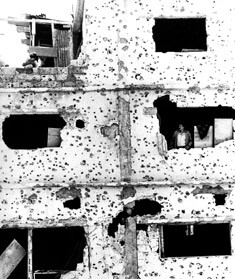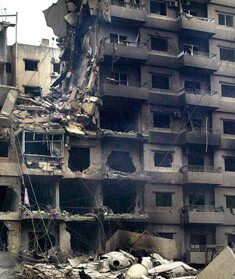The Electronic Intifada 7 August 2006

Lebanon 1982: Bullet and bomb-damaged buildings visible symbols of lives again torn apart by war. Heavy fighting in the vicinity of Beirut during the invasion prompted many people to flee for safety.

Lebanon 2006: A general view of damaged buildings after Israeli warplanes targeted residential areas in Beirut on July 21, 2006. (Haitham Moussawi/IRIN)
People walk the dusty, broken roads in scorching summer heat, taking shelter in the basements of empty buildings. In Gaza and Lebanon, in the refugee camps of Khan Younis, Rafah and Jabaliya, in Tyre and Beirut, in Nabatiyeh and Sidon, hundreds of thousands of men, women and children seek refuge. As they flee, they risk the indiscriminate wrath of an enemy driven by an existential mania that can not be assuaged, only stopped. Ambulances are struck, humanitarian relief convoys are struck, UN observers are struck. Warning leaflets are dropped from the sky urging people to abandon their homes, just as they were in 1996, 1982, 1978, 1967 and 1948. The ultimately impossible decision in Gaza and Lebanon today is: where does a refugee go?
In Beirut in July 1982, after surviving a bomb that destroyed a seven-floor apartment block next door to me, burying alive more than 40 people taking refuge in its cellar, some of us began to sleep on the roof; there is no refuge from this terror, there is only resistance. Fifteen of the 37 children killed in Qana on Sunday were disabled; their families could take them no further north, according to the Lebanese MP Bahia Hariri. From June to August 1982, Israeli aircraft flying over Lebanon dropped “smart bombs” on children’s hospitals in Shatila camp, Gaza hospital, Acre hospital and 11 of the country’s orphanages, killing dozens of disabled children. They had nowhere else to shelter. The roofs had been painted with huge white crosses visible from the sky.
That war did not give Israel the security it claims to seek, and nor will this one. In 1948 Palestinians fled after hearing news of the massacres in villages by Haganah forces and receiving leaflets dropped from the sky telling them to run for their lives. This week their grandchildren and great-grandchildren are being killed with impunity in the refugee camps of Gaza, where they are trapped. Last Friday alone more than 30 Palestinians were killed, with no international condemnation and barely a mention in the press. In Qana they were also trapped. “We couldn’t get out of our neighbourhood because there are only two roads leading out and the Israelis bombed them both several days ago,” said Mohammad Shalhoub, a disabled 41-year-old survivor.
The US and Britain are claiming that no ceasefire is possible until there is an international force that will implement United Nations resolution 1559. Yet the Lebanese prime minister issued a seven-point plan in Rome last week, consistent with international law and agreed by all elected parties in Lebanon (including Hizbullah), that had as its first requirement an immediate and unconditional ceasefire. It is implementation of the dozens of UN resolutions that Israel has flouted for more than 50 years with protection from the US - and now from Britain - that will stop this conflict.
The ultimately impossible decision in Gaza and Lebanon today is: where does a refugee go?
The capture of a soldier from an occupying army in Gaza, and of two soldiers on the Lebanese border by local resistance, in an attempt to force the release of thousands of illegally detained Palestinian and Lebanese prisoners, should have been dealt with by Israel in the framework of the laws of war and with a proportional response. Instead, by launching this massive attack, Israel has destroyed the social and economic infrastructure of a sovereign nation, Lebanon, just as it is destroying the infrastructure of a democratically elected administration in occupied Palestine.
It is producing generations of refugees who will also resist. Power stations, bridges, key manufacturing and food factories in Lebanon are ruined, the entire industrial estate of Gaza pulverised. The ancient city centre of Nablus has been demolished. Whole villages in south Lebanon and sections of refugee camps in Gaza have been obliterated. These too are war crimes. If Britain will not stop Israel, nor condemn it, then under the Geneva conventions it is complicit in those crimes.
Before seeking the implementation of UN resolution 1559, which calls for the disarmament of Hizbullah, Britain must seek with more sincerity the implementation of UN security council resolutions 242 and 338, which demand the immediate withdrawal of Israel from lands illegally occupied in the 1967 war, including the Golan Heights, the West Bank (including East Jerusalem) and Gaza. There is hardly a statesman or citizen in the world today who cannot see that it will take outside intervention to stop Israel inflicting this terror. Calling for an immediate and unconditional ceasefire, and working towards the implementation of all UN resolutions addressing this conflict, will restore to the international community - and Britain in particular - the legitimacy it has squandered by allowing months of war crimes to go by, witnessed but uncondemned and unconstrained.
Israel has failed to understand that it cannot expel a people and call itself the victim; that it cannot conquer its neighbours and treat any and all resistance to that conquest as terrorism; that it cannot arm itself as a regional superpower and annihilate the institutional fabric of two peoples without incurring the fury of their children in the years that follow.
Karma Nabulsi teaches politics and international relations at Oxford University. She is the author of Traditions of War: Occupation, Resistance and the Law. This article was first published in The Guardian on August 2, 2006 and reprinted on EI with permission.
Related Links




